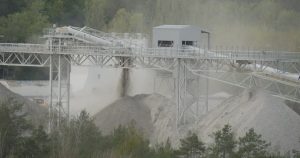REMOVE DUST IN CEMENT PLANTS:

When working in a cement plant, processing dust is a constant issue. Mixing product, filling bags and containers, and operating conveyors, somehow a cloud of dust and fumes always seems to appear. Some activities cause more than others, but controlling all types and causes of those contaminants is a key need of any cement plant. Air Cleaning Blowers, LLC can help remove dust in cement plants.
The Air Cleaning BlowerTM (ACB) was developed specifically to remove dust, pollen and other particles from the air in dusty and corrosive environments while eliminating the need for constant maintenance due to clogging filters. After removing most kinds of dusts caused by operations, without using any filter elements or media, the ACBs blow out clean air to your application.
HOW DOES IT WORK?
The Air Cleaning BlowerTM works by pulling dirty air into its housing like any other fan would. The impeller inside its housing then spins the air around in a novel, multi-patented way, using the momentum of the particles to separate the dusts and other particles from the air. The ACB then ejects the debris back into the place where it came from, such as a conveyor loading a silo to keep the dust from escaping. The clean air then blows out the other side where you need it. The Air-Cleaning BlowerTM accomplishes all this without any type of filter elements or media that need replacement or other maintenance.
Other filters and air purifiers that use filter elements often clog quickly and expensively. This clogging decreases the effectiveness of the fan, increases the amount of energy consumption and requires constant maintenance and repair. In contrast, because the ACB has no filter media to clog, replace or maintain, you can be sure you generate constant air flow, air pressure and steady energy consumption for ventilating, pressurizing or feeding air compressors and other equipment. They can also blow clean air into an evaporative (swamp) cooler.
RAIN, MIST & SNOW:
Another key feature is that the ACBs can remove rain, mist and snow from the air, helping the air stay dryer and reducing the load on any air conditioning, refrigeration or dehumidifying equipment. This can especially help in cement plants when keeping the dry cement and limestone dry is a requirement. In addition, because there is no filter media catching that rain or snow, there is nothing that will become wet or freeze up and prevent the air from passing through.
An internationally-recognized filter-testing laboratory tested the ACBs to establish independently their effectiveness. The testing found that they remove up to 98%+ of the mass of dust and other particles in the air. The laboratory results show that they remove virtually all particles larger than 10 microns and about 40% of smaller particles down to 3 microns in the air. The smallest particles most people can see are about 50 microns. This level of effectiveness is better than that of most air-conditioning systems, and in most cases it would take months for enough dust to accumulate to create an insulating blanket that could overheat a motor or an electric box.
Originally developed to work in harsh environments such as steel, mining and fertilizer plants, the Air Cleaning BlowerTM can help remove dust in cement plants, no matter what kind of cement or other plant you operate. Our ACBs are so effective that they are being used today by the US Military in the Middle East to keep air conditioners cooling, even in sandstorms.
POTENTIAL APPLICATIONS
-
Pressurizing and/or ventilating with clean air electrical enclosures, motor control centers, transformers, and switchgear to keep out dust
-
Pressurizing offices with clean air to keep out dust
-
Ventilating data centers to reduce use of air conditioning
-
Removing Dust in Cement Plants
-
Ventilating and pressurizing operators’ cabins on equipment and elsewhere
-
Removing dust in the air for employees to breathe easier
-
Controlling dust at silos used for road and other heavy construction
-
Supplying air compressors with clean air
-
Controlling dust at loading points for trucks, rail cars and ships
-
Supplying clean air for control stations in rock-processing domes
-
Controlling dust in limestone mines and quarries

